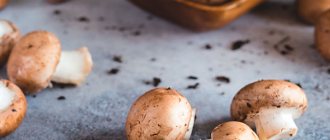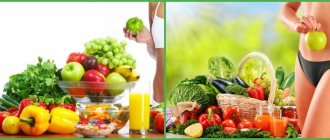Foods Rich in Vitamin A
Most products contain it in the form of provitamins - inactive compounds that are “activated” after entering the human body. Provitamins include carotenoids (the most valuable is beta-carotene). Carotenoids are yellow, orange or red in color and are found in plant foods. In this regard, it is always easy to “find out” which foods are rich in provitamin A. These are carrots, pumpkin, peaches, strawberries, tomatoes, melon and much more. “Real” vitamin A, retinol, is found in animal products. There is a lot of it in the liver; it is also present in some quantities in egg yolks, milk, cottage cheese, and cheese.
A balanced diet usually contains a sufficient amount of vitamin A. In summer, its intake occurs mainly from plant sources, in winter - from animals. However, since the latter “dosage” of vitamin A is smaller, in the cold season people often become prone to developing hypovitaminosis.
Vitamin A content in foods
Table of percentage of vitamin A in foods. The chart shows the percentage of vitamin A from the daily requirement, calculated based on a 100 g serving of the product.
| № | Quantity | Share of daily value per 100 g | |
| 1 | Cod liver oil, raw | 30,000.0 mcg | 3 333,3% |
| 2 | Duck liver raw | 11,984.0 mcg | 1 331,6% |
| 3 | Stewed turkey liver | 10,751.0 mcg | 1 194,6% |
| 4 | Beef liver, stewed or fried | 9,442.0 mcg | 1 049,1% |
| 5 | Raw goose liver | 9,309.0 mcg | 1 034,3% |
| 6 | Turkey liver raw | 8,058.0 mcg | 895,3% |
| 7 | Raw pork liver | 6,502.0 mcg | 722,4% |
| 8 | Pork liver fried or stewed | 5,405.0 mcg | 600,6% |
| 9 | Beef liver raw | 4,968.0 mcg | 552,0% |
| 10 | Fried chicken liver | 4,296.0 mcg | 477,3% |
| 11 | Chicken liver stewed or boiled | 3,981.0 mcg | 442,3% |
| 12 | Dried carrots | 3,423.0 mcg | 380,3% |
| 13 | Chicken liver raw | 3,296.0 mcg | 366,2% |
| 14 | Paprika spice, powder form | 2,463.0 mcg | 273,7% |
| 15 | Ground dry chili pepper | 1,483.0 mcg | 164,8% |
| 16 | Fresh grape leaves | 1,376.0 mcg | 152,9% |
| 17 | Hot chili peppers dried in the sun | 1,324.0 mcg | 147,1% |
| 18 | Baked or smoked eel | 1,137.0 mcg | 126,3% |
| 19 | Milk Protein Supplement Powder | 1,050.0 mcg | 116,7% |
| 20 | Raw eel | 1,043.0 mcg | 115,9% |
| 21 | Foie gras canned | 1,001.0 mcg | 111,2% |
| 22 | Liver pate | 991.0 mcg | 110,1% |
| 23 | Baked sweet potato | 961.0 mcg | 106,8% |
| 24 | Canned carrot juice | 956.0 mcg | 106,2% |
| 25 | Boiled carrots | 852.0 mcg | 94,7% |
| 26 | Butter | 840.0 mcg | 93,3% |
| 27 | Carrots raw (fresh) | 835.0 mcg | 92,8% |
| 28 | Margarine | 819.0 mcg | 91,0% |
| 29 | Frozen carrots | 710.0 mcg | 78,9% |
| 30 | Raw sweet potato | 709.0 mcg | 78,8% |
| 31 | Dried apricots low water content | 633.0 mcg | 70,3% |
| 32 | Frozen spinach | 586.0 mcg | 65,1% |
| 33 | Quinoa fresh | 580.0 mcg | 64,4% |
| 34 | Fresh turnip tops | 579.0 mcg | 64,3% |
| 35 | Canned carrots | 558.0 mcg | 62,0% |
| 36 | Butternut squash raw | 532.0 mcg | 59,1% |
| 37 | Dried mint | 529.0 mcg | 58,8% |
| 38 | Boiled spinach | 524.0 mcg | 58,2% |
| 39 | Fresh dandelion leaves | 508.0 mcg | 56,4% |
| 40 | Raw curly cabbage | 500.0 mcg | 55,6% |
| 41 | Fresh mustard spinach | 495.0 mcg | 55,0% |
| 42 | Canned spinach | 490.0 mcg | 54,4% |
| 43 | Chicken egg yolk in powder form | 477.0 mcg | 53,0% |
| 44 | Fresh spinach | 469.0 mcg | 52,1% |
| 45 | Fresh Roman salad | 436.0 mcg | 48,4% |
| 46 | Raw milkweed shoots | 435.0 mcg | 48,3% |
| 47 | Raw pumpkin | 426.0 mcg | 47,3% |
| 48 | Fresh parsley | 421.0 mcg | 46,8% |
| 49 | Beef kidneys raw | 419.0 mcg | 46,6% |
| 50 | Goat cheese | 407.0 mcg | 45,2% |
| 51 | Marjoram spice powder | 403.0 mcg | 44,8% |
| 52 | Boiled white mari | 391.0 mcg | 43,4% |
| 53 | Fresh dill | 386.0 mcg | 42,9% |
| 54 | Raw egg yolk | 381.0 mcg | 42,3% |
| 55 | Cooked cabbage (boiled) | 380.0 mcg | 42,2% |
| 56 | Fresh red lettuce | 375.0 mcg | 41,7% |
| 57 | Fresh lettuce | 370.0 mcg | 41,1% |
| 58 | Powdered egg replacers | 369.0 mcg | 41,0% |
| 59 | Fresh corn salad | 355.0 mcg | 39,4% |
| 60 | Fresh watercress | 346.0 mcg | 38,4% |
| 61 | Cheese Limburger | 340.0 mcg | 37,8% |
| 62 | Cilantro (coriander leaves) fresh | 337.0 mcg | 37,4% |
| 63 | Cheese Brunust | 334.0 mcg | 37,1% |
| 64 | Cheddar cheese | 330.0 mcg | 36,7% |
| 65 | Fresh beet tops | 316.0 mcg | 35,1% |
| 66 | Cheese Port-Salut | 315.0 mcg | 35,0% |
| 67 | Bay leaf | 309.0 mcg | 34,3% |
| 68 | Cream cheese | 308.0 mcg | 34,2% |
| 69 | Fresh chard | 306.0 mcg | 34,0% |
| 70 | Processed cheese | 302.0 mcg | 33,6% |
| 71 | Munster cheese | 298.0 mcg | 33,1% |
| 72 | Ground sage | 295.0 mcg | 32,8% |
| 73 | Roquefort cheese | 294.0 mcg | 32,7% |
| 74 | Dried openwork chervil | 293.0 mcg | 32,6% |
| 75 | Dried coriander (cilantro) leaf | 293.0 mcg | 32,6% |
| 76 | Dried dill | 293.0 mcg | 32,6% |
| 77 | Swiss cheese | 288.0 mcg | 32,0% |
| 78 | Boiled or baked pumpkin | 288.0 mcg | 32,0% |
| 79 | Fresh chicory leaves | 286.0 mcg | 31,8% |
| 80 | Baked omul | 283.0 mcg | 31,4% |
| 81 | Gruyère cheese | 271.0 mcg | 30,1% |
| 82 | Colby cheese | 264.0 mcg | 29,3% |
| 83 | Fresh basil | 264.0 mcg | 29,3% |
| 84 | Baked sturgeon | 263.0 mcg | 29,2% |
| 85 | Cheese Fontina | 261.0 mcg | 29,0% |
| 86 | Nori seaweed, raw | 260.0 mcg | 28,9% |
| 87 | Salted herring | 258.0 mcg | 28,7% |
| 88 | Powdered milk | 258.0 mcg | 28,7% |
| 89 | Ground savory | 257.0 mcg | 28,6% |
| 90 | Fresh kale | 251.0 mcg | 27,9% |
| 91 | Cheese Tilsiter | 249.0 mcg | 27,7% |
| 92 | Edam cheese | 243.0 mcg | 27,0% |
| 93 | Camembert cheese | 241.0 mcg | 26,8% |
| 94 | Cheese Neuchatel | 241.0 mcg | 26,8% |
| 95 | Fresh thyme | 238.0 mcg | 26,4% |
| 96 | Provolone cheese | 236.0 mcg | 26,2% |
| 97 | Cheshire cheese | 233.0 mcg | 25,9% |
| 98 | Mexican Cotija cheese | 229.0 mcg | 25,4% |
| 99 | Broccoli raab cooked | 227.0 mcg | 25,2% |
| 100 | Cheese Queso Fresco | 224.0 mcg | 24,9% |
| 101 | Fresh Chinese cabbage | 223.0 mcg | 24,8% |
| 102 | Mozzarella cheese | 223.0 mcg | 24,8% |
| 103 | Fried chicken egg | 219.0 mcg | 24,3% |
| 104 | Fresh chives | 218.0 mcg | 24,2% |
| 105 | Fresh peppermint | 212.0 mcg | 23,6% |
| 106 | Raw sturgeon | 210.0 mcg | 23,3% |
| 107 | Dried tarragon | 210.0 mcg | 23,3% |
| 108 | Parmesan cheese | 207.0 mcg | 23,0% |
| 109 | Fresh mint | 203.0 mcg | 22,6% |
| 110 | Cooked cuttlefish | 203.0 mcg | 22,6% |
| 111 | Fresh sorrel | 200.0 mcg | 22,2% |
| 112 | Fresh green onion | 200.0 mcg | 22,2% |
| 113 | Monterey cheese | 198.0 mcg | 22,0% |
| 114 | Blue cheeses | 198.0 mcg | 22,0% |
| 115 | Raw duck egg | 194.0 mcg | 21,6% |
| 116 | Dried thyme | 190.0 mcg | 21,1% |
| 117 | Raw goose egg | 187.0 mcg | 20,8% |
| 118 | Fern (shoots) raw | 181.0 mcg | 20,1% |
| 119 | Fireweed (fireweed leaves) fresh | 180.0 mcg | 20,0% |
| 120 | Dried apricots | 180.0 mcg | 20,0% |
| 121 | Brie cheese | 174.0 mcg | 19,3% |
| 122 | Egg omelette | 172.0 mcg | 19,1% |
| 123 | Boiled shellfish | 171.0 mcg | 19,0% |
| 124 | Kefir | 171.0 mcg | 19,0% |
| 125 | Fresh cantaloupe melon | 169.0 mcg | 18,8% |
| 126 | Turkey egg raw | 166.0 mcg | 18,4% |
| 127 | Fresh head lettuce | 166.0 mcg | 18,4% |
| 128 | Gouda cheese | 165.0 mcg | 18,3% |
| 129 | Raw beetroot | 160.0 mcg | 17,8% |
| 130 | Raw chicken egg | 160.0 mcg | 17,8% |
| 131 | Cheesecake | 159.0 mcg | 17,7% |
| 132 | Dry muesli (with dried fruits and nuts) | 157.0 mcg | 17,4% |
| 133 | Fresh red bell pepper | 157.0 mcg | 17,4% |
| 134 | Raw quail egg | 156.0 mcg | 17,3% |
| 135 | Dried rosemary | 156.0 mcg | 17,3% |
| 136 | Fresh mustard greens | 151.0 mcg | 16,8% |
| 137 | Baked chinook salmon | 149.0 mcg | 16,6% |
| 138 | Boiled chicken egg (hard-boiled) | 149.0 mcg | 16,6% |
| 139 | Canned apricots | 146.0 mcg | 16,2% |
| 140 | Fresh rosemary | 146.0 mcg | 16,2% |
| 141 | Fresh amaranth leaves | 146.0 mcg | 16,2% |
| 142 | Chinook salmon raw | 136.0 mcg | 15,1% |
| 143 | Fresh broccoli raab | 131.0 mcg | 14,6% |
| 144 | Baked catfish | 130.0 mcg | 14,4% |
| 145 | Canned horse mackerel | 130.0 mcg | 14,4% |
| 146 | Chees Feta | 125.0 mcg | 13,9% |
| 147 | Frozen red bell pepper | 121.0 mcg | 13,4% |
| 148 | Fresh arugula | 119.0 mcg | 13,2% |
| 149 | Ice cream | 118.0 mcg | 13,1% |
| 150 | Chocolate ice cream | 118.0 mcg | 13,1% |
| 151 | Raw catfish | 113.0 mcg | 12,6% |
| 152 | Raw cuttlefish | 113.0 mcg | 12,6% |
| 153 | Dried peach | 108.0 mcg | 12,0% |
| 154 | Fresh endive | 108.0 mcg | 12,0% |
| 155 | Ricotta cheese | 107.0 mcg | 11,9% |
| 156 | Frozen green peas | 103.0 mcg | 11,4% |
| 157 | Dried parsley | 97.0 mcg | 10,8% |
| 158 | Fresh pumpkin leaves | 97.0 mcg | 10,8% |
| 159 | Fresh apricot | 96.0 mcg | 10,7% |
| 160 | Pecorino Romano cheese | 96.0 mcg | 10,7% |
| 161 | Escarole cooked | 94.0 mcg | 10,4% |
| 162 | Boiled mussels | 91.0 mcg | 10,1% |
| 163 | Caviar, red or black, cooked (heat-treated) | 91.0 mcg | 10,1% |
| 164 | Raw shellfish | 90.0 mcg | 10,0% |
| 165 | Boiled octopus | 90.0 mcg | 10,0% |
| 166 | Caviar, red or black, raw | 90.0 mcg | 10,0% |
| 167 | Sour cream | 90.0 mcg | 10,0% |
| 168 | Dried plum low water content | 88.0 mcg | 9,8% |
| 169 | Cooked chicken back (meat with skin) | 88.0 mcg | 9,8% |
| 170 | Chinese fresh broccoli | 86.0 mcg | 9,6% |
| 171 | Oregano oregano, dried | 85.0 mcg | 9,4% |
| 172 | Raw turkey skin | 85.0 mcg | 9,4% |
| 173 | Fresh leek | 83.0 mcg | 9,2% |
| 174 | Turkey heart raw | 82.0 mcg | 9,1% |
| 175 | Chinese cooked broccoli | 82.0 mcg | 9,1% |
| 176 | Stewed pork kidneys | 78.0 mcg | 8,7% |
| 177 | Boiled broccoli | 77.0 mcg | 8,6% |
| 178 | Fresh medlar | 76.0 mcg | 8,4% |
| 179 | Canned tomato paste | 76.0 mcg | 8,4% |
| 180 | Raw chicken skin | 76.0 mcg | 8,4% |
| 181 | Fresh Suriname cherries | 75.0 mcg | 8,3% |
| 182 | Fresh orange tomatoes | 75.0 mcg | 8,3% |
| 183 | Chicken back raw, meat with skin | 75.0 mcg | 8,3% |
| 184 | Condensed milk | 74.0 mcg | 8,2% |
| 185 | Swept fat-free | 73.0 mcg | 8,1% |
| 186 | Dried peach | 71.0 mcg | 7,9% |
| 187 | Shark meat raw | 70.0 mcg | 7,8% |
| 188 | Cottage cheese 2% fat | 68.0 mcg | 7,6% |
| 189 | Hubbard pumpkin raw | 68.0 mcg | 7,6% |
| 190 | Dried mango | 67.0 mcg | 7,4% |
| 191 | Canned apricot juice (nectar) | 66.0 mcg | 7,3% |
| 192 | Jeera cumin seeds | 64.0 mcg | 7,1% |
| 193 | Baked seabass | 64.0 mcg | 7,1% |
| 194 | Mexican cheese Anejo | 64.0 mcg | 7,1% |
| 195 | Fresh cherries | 64.0 mcg | 7,1% |
| 196 | Fresh passion fruit | 64.0 mcg | 7,1% |
| 197 | Mahi-mahi (korifena) baked | 62.0 mcg | 6,9% |
| 198 | Breast milk | 61.0 mcg | 6,8% |
| 199 | Milk chocolate | 59.0 mcg | 6,6% |
| 200 | Green hot chili pepper fresh | 59.0 mcg | 6,6% |
| 201 | Raw pork kidneys | 59.0 mcg | 6,6% |
| 202 | Fresh grapefruit | 58.0 mcg | 6,4% |
| 203 | Baked sockeye salmon | 58.0 mcg | 6,4% |
| 204 | Broccoli frozen | 57.0 mcg | 6,3% |
| 205 | Goat milk | 57.0 mcg | 6,3% |
| 206 | Cooked pheasant | 57.0 mcg | 6,3% |
| 207 | Fried or baked zucchini (without oil) | 56.0 mcg | 6,2% |
| 208 | Fresh red cabbage | 56.0 mcg | 6,2% |
| 209 | Fresh plantains | 56.0 mcg | 6,2% |
| 210 | Mexican Cheese Queso Chihuahua | 56.0 mcg | 6,2% |
| 211 | Mexican cheese Oaxaca | 55.0 mcg | 6,1% |
| 212 | Mahi-mahi (korifena) raw | 54.0 mcg | 6,0% |
| 213 | Baked mackerel | 54.0 mcg | 6,0% |
| 214 | Fried shark meat | 54.0 mcg | 6,0% |
| 215 | Mango fresh | 54.0 mcg | 6,0% |
| 216 | Raw pheasant meat | 53.0 mcg | 5,9% |
| 217 | Baked coho salmon | 51.0 mcg | 5,7% |
| 218 | Baked grouper | 50.0 mcg | 5,6% |
| 219 | Fresh savoy cabbage | 50.0 mcg | 5,6% |
| 220 | Raw mackerel | 50.0 mcg | 5,6% |
| 221 | Boiled asparagus | 50.0 mcg | 5,6% |
| 222 | Raw sockeye salmon | 49.0 mcg | 5,4% |
| 223 | Raw mussels | 48.0 mcg | 5,3% |
| 224 | Fennel, raw (fruit or root) | 48.0 mcg | 5,3% |
| 225 | Red hot fresh chili pepper | 48.0 mcg | 5,3% |
| 226 | Fresh papaya | 47.0 mcg | 5,2% |
| 227 | Salted mackerel | 47.0 mcg | 5,2% |
| 228 | Frozen asparagus | 47.0 mcg | 5,2% |
| 229 | Ryazhenka | 47.0 mcg | 5,2% |
| 230 | Snickers chocolate bar | 46.0 mcg | 5,1% |
| 231 | Yogurt | 46.0 mcg | 5,1% |
| 232 | Turkey gizzards raw | 46.0 mcg | 5,1% |
| 233 | Seabass raw | 46.0 mcg | 5,1% |
| 234 | Octopus raw | 45.0 mcg | 5,0% |
| 235 | Plantains cooked | 45.0 mcg | 5,0% |
| 236 | Chicken thighs, boiled or stewed (meat with skin) | 45.0 mcg | 5,0% |
| 237 | Sheep milk | 44.0 mcg | 4,9% |
| 238 | Frozen cherries | 44.0 mcg | 4,9% |
| 239 | Grouper raw | 43.0 mcg | 4,8% |
| 240 | Baked swordfish | 43.0 mcg | 4,8% |
| 241 | Cowpea raw | 43.0 mcg | 4,8% |
| 242 | Baked pink salmon | 42.0 mcg | 4,7% |
| 243 | Fresh tomatoes | 42.0 mcg | 4,7% |
| 244 | Baked mullet | 42.0 mcg | 4,7% |
| 245 | Canned asparagus | 41.0 mcg | 4,6% |
| 246 | Leeks cooked | 41.0 mcg | 4,6% |
| 247 | Nutmeg spice, ground | 40.0 mcg | 4,4% |
| 248 | Boiled green peas | 40.0 mcg | 4,4% |
| 249 | Smoked herring | 40.0 mcg | 4,4% |
| 250 | Coho salmon raw | 40.0 mcg | 4,4% |
| 251 | Chicken wings, boiled or stewed | 40.0 mcg | 4,4% |
| 252 | Boiled Brussels sprouts | 39.0 mcg | 4,3% |
| 253 | Fresh green peas | 38.0 mcg | 4,2% |
| 254 | Fresh Brussels sprouts | 38.0 mcg | 4,2% |
| 255 | Mashed potatoes with milk and butter, prepared | 38.0 mcg | 4,2% |
| 256 | Raw asparagus | 38.0 mcg | 4,2% |
| 257 | Fried chicken wings | 38.0 mcg | 4,2% |
| 258 | Barbados cherry fresh | 38.0 mcg | 4,2% |
| 259 | Baked whiting | 38.0 mcg | 4,2% |
| 260 | Dry basil | 37.0 mcg | 4,1% |
| 261 | Raw mullet | 37.0 mcg | 4,1% |
| 262 | Boiled or stewed chicken legs (meat with skin) | 37.0 mcg | 4,1% |
| 263 | Physalis fresh | 36.0 mcg | 4,0% |
| 264 | Raw swordfish | 36.0 mcg | 4,0% |
| 265 | Baked herring | 36.0 mcg | 4,0% |
| 266 | Raw okra | 36.0 mcg | 4,0% |
| 267 | Molva baked | 35.0 mcg | 3,9% |
| 268 | Baked river perch | 35.0 mcg | 3,9% |
| 269 | Pink salmon raw | 35.0 mcg | 3,9% |
| 270 | Raw green beans, asparagus | 35.0 mcg | 3,9% |
| 271 | Baked snapper (berix) | 35.0 mcg | 3,9% |
| 272 | Mango juice (nectar) canned | 35.0 mcg | 3,9% |
| 273 | Baked chum salmon | 34.0 mcg | 3,8% |
| 274 | Fresh tangerines | 34.0 mcg | 3,8% |
| 275 | Baked milkfish (hanos) | 33.0 mcg | 3,7% |
| 276 | Smoked butterfish (escolar) | 33.0 mcg | 3,7% |
| 277 | Whole cow's milk 3.7% fat | 33.0 mcg | 3,7% |
| 278 | Green tomatoes, raw | 32.0 mcg | 3,6% |
| 279 | Canned sardine in oil | 32.0 mcg | 3,6% |
| 280 | Snapper (berix) raw | 32.0 mcg | 3,6% |
| 281 | Boiled green beans (asparagus) | 32.0 mcg | 3,6% |
| 282 | Fresh guava | 31.0 mcg | 3,4% |
| 283 | Baked Yellowtail (Lacedra) | 31.0 mcg | 3,4% |
| 284 | Brussels sprouts frozen | 31.0 mcg | 3,4% |
| 285 | Canned peaches | 31.0 mcg | 3,4% |
| 286 | Chocolate bar Milky Way | 31.0 mcg | 3,4% |
| 287 | Fresh broccoli | 31.0 mcg | 3,4% |
| 288 | Merlang raw | 30.0 mcg | 3,3% |
| 289 | Molva raw | 30.0 mcg | 3,3% |
| 290 | Raw river perch | 30.0 mcg | 3,3% |
| 291 | Raw omul | 30.0 mcg | 3,3% |
| 292 | Chum salmon raw | 30.0 mcg | 3,3% |
| 293 | Chicken back (without skin) raw | 30.0 mcg | 3,3% |
| 294 | Milkfish (hanos) raw | 30.0 mcg | 3,3% |
| 295 | Cooked chicken feet | 30.0 mcg | 3,3% |
| 296 | Fresh elderberry | 30.0 mcg | 3,3% |
| 297 | Raw snails | 30.0 mcg | 3,3% |
| 298 | Oilfish (escolar) raw | 30.0 mcg | 3,3% |
| 299 | Yellowtail (lacedra) raw | 29.0 mcg | 3,2% |
| 300 | Dried spirulina (in powder form) | 29.0 mcg | 3,2% |
| 301 | Fried chicken thighs (meat with skin) | 29.0 mcg | 3,2% |
| 302 | Naranjilla frozen | 28.0 mcg | 3,1% |
| 303 | Iris | 28.0 mcg | 3,1% |
| 304 | Herring raw | 28.0 mcg | 3,1% |
| 305 | Cow's milk 2% fat | 28.0 mcg | 3,1% |
| 306 | Fresh watermelon | 28.0 mcg | 3,1% |
| 307 | Fried chicken legs (meat with skin) | 28.0 mcg | 3,1% |
| 308 | Chicken legs (legs) raw, meat with skin | 28.0 mcg | 3,1% |
| 309 | Canned green peas | 27.0 mcg | 3,0% |
| 310 | Ground allspice | 27.0 mcg | 3,0% |
| 311 | Saffron spice | 27.0 mcg | 3,0% |
| 312 | Ground black pepper | 27.0 mcg | 3,0% |
| 313 | Zucchini caviar, canned zucchini | 27.0 mcg | 3,0% |
| 314 | Chicken drumstick, stewed or boiled (meat with skin) | 27.0 mcg | 3,0% |
| 315 | Frozen green beans (asparagus) | 27.0 mcg | 3,0% |
| 316 | Fresh pistachios | 26.0 mcg | 2,9% |
| 317 | Ketchup | 26.0 mcg | 2,9% |
| 318 | Young zucchini, raw | 25.0 mcg | 2,8% |
| 319 | Fresh iceberg lettuce | 25.0 mcg | 2,8% |
| 320 | Fried chicken drumstick (meat with skin) | 25.0 mcg | 2,8% |
| 321 | Baked halibut | 24.0 mcg | 2,7% |
| 322 | KitKat chocolate bar | 24.0 mcg | 2,7% |
| 323 | Cooked pike | 24.0 mcg | 2,7% |
| 324 | Cooked tomatoes | 24.0 mcg | 2,7% |
| 325 | Duck (duck meat) raw meat, without skin | 24.0 mcg | 2,7% |
| 326 | Baked pike perch | 24.0 mcg | 2,7% |
| 327 | Chicken breast raw, skin on | 24.0 mcg | 2,7% |
| 328 | Fried croaker | 23.0 mcg | 2,6% |
| 329 | Prickly pear (leaves) raw | 23.0 mcg | 2,6% |
| 330 | Canned tomato juice, no salt | 23.0 mcg | 2,6% |
| 331 | Raw chicken thighs, meat with skin | 23.0 mcg | 2,6% |
| 332 | Duck (duck meat) baked (meat without skin) | 23.0 mcg | 2,6% |
| 333 | Cooked cowpea (boiled) | 23.0 mcg | 2,6% |
| 334 | Fresh grapefruit juice | 22.0 mcg | 2,4% |
| 335 | Fresh celery | 22.0 mcg | 2,4% |
| 336 | Baked goose | 21.0 mcg | 2,3% |
| 337 | Raw pike perch | 21.0 mcg | 2,3% |
| 338 | Fresh orange zest | 21.0 mcg | 2,3% |
| 339 | Raw pike | 21.0 mcg | 2,3% |
| 340 | Baked menek | 21.0 mcg | 2,3% |
| 341 | Canned green olives | 20.0 mcg | 2,2% |
| 342 | Halibut raw | 20.0 mcg | 2,2% |
| 343 | Twix chocolate bar | 20.0 mcg | 2,2% |
| 344 | Surimi raw | 20.0 mcg | 2,2% |
| 345 | Crab sticks (surimi) ready to eat | 20.0 mcg | 2,2% |
| 346 | Baked chicken legs (meat with skin) | 20.0 mcg | 2,2% |
| 347 | Baked oysters | 20.0 mcg | 2,2% |
| 348 | Baked trout | 19.0 mcg | 2,1% |
| 349 | Skinless chicken thighs, boiled or stewed | 19.0 mcg | 2,1% |
| 350 | Raw chicken gizzards | 19.0 mcg | 2,1% |
Absorption of vitamin A from food
Attention! Pregnancy is NOT a condition that significantly increases the need for this substance. It does not increase to such an extent that it is necessary to take it in additional large quantities. Vitamin A in the diet and in complexes for pregnant women will be more than enough. If you create an “overdose,” especially in the early stages of pregnancy, this threatens the appearance of malformations in the fetus. Be careful!
About a third of provitamin A is absorbed into the gastrointestinal tract from plant sources. To increase its absorption, it is recommended to consume fatty foods along with plant foods rich in carotenoids. For example, it is advisable to add a little sunflower or olive oil to carrot juice. Animal sources supply the vitamin in a form that is almost completely absorbed.
Vitamin A (retinol)
This is a measurement of retinol levels, a precursor to vitamin A.
Synonyms Russian
True vitamin A, trans-9,13-dimethyl-7-(1,1,5-trimethylcyclohexen-5-yl-6)-nonatetraen-7,9,11,13-ol, antixerophthalmic vitamin, avital, axerophthol.
English synonyms
Retinol, afaxin, agiolan, alphalin, alphasterol, apexol, ophthalamin, prepalin, retinol.
Research method
High performance liquid chromatography-mass spectrometry (HPLC-MS).
Units
µg/ml (micrograms per milliliter).
What biomaterial can be used for research?
Venous blood.
How to properly prepare for research?
- Do not eat for 2-3 hours before the test; you can drink clean still water.
- Do not smoke 30 minutes before the test.
General information about the study
The test determines the level of retinol, the primary form of vitamin A, in the blood.
Vitamin A is necessary for normal vision, the functioning of the immune system and embryonic development, for the growth and integrity of skin, and bone formation. In addition, it is needed for the formation of ocular photoreceptors, to maintain the structure and integrity of the lining surface of the eyes and other mucous membranes. A lack of vitamin A can lead to hemeralopia, eye damage and, in severe cases, even blindness. Acute or chronic excess of vitamin A can be toxic and lead to fetal pathology.
A person is not able to produce vitamin A, he can only obtain it from food. Meat contains it in the form of retinol, while vegetables and fruits are a source of carotene (a substance that is converted into vitamin A by the liver).
Vitamin A is stored in the liver and adipose tissue (it is fat soluble), and a healthy adult body can accumulate a significant supply of it. A relatively stable concentration of the vitamin in the blood is maintained through a feedback mechanism that promotes its release from stores as needed and also increases or decreases its absorption from food.
Vitamin A deficiency mainly affects those who have an unhealthy diet and those who have malabsorption syndromes (malabsorption syndrome), especially people suffering from celiac disease, cystic fibrosis, chronic pancreatitis, as well as the elderly and patients with alcoholism and liver disease .
The toxic effect of vitamin A is mainly caused by the abuse of vitamin supplements. However, sometimes it is caused by large amounts of food containing high concentrations of vitamin A, such as liver.
What is the research used for?
- To help diagnose vitamin A deficiency for symptoms such as night blindness and diseases that impair intestinal absorption of nutrients.
- To determine the level of toxicity caused by consuming large amounts of vitamin A.
When is the study scheduled?
- For symptoms of vitamin A deficiency or general malnutrition: night blindness,
- dry eyes, skin, hair,
- ulcers and damage to the cornea (the outer layer of the eye that covers the iris and pupil),
- thinning of the skin,
- gray-green spots on the lining membrane,
- chronic infections,
- anemia.
- celiac disease,
- headache,
What do the results mean?
Reference values: 0.30 - 0.80 µg/ml.
A normal reading on this test means that the patient has sufficient vitamin A at the moment. However, the analysis does not reveal what its reserve is in the body. The concentration of vitamin A in the blood is maintained at a stable level until its reserves are depleted. Accordingly, a low level of vitamin A indicates that all reserves have been exhausted and the patient is experiencing a deficiency.
An increased level of vitamin A, as a rule, indicates that the body’s ability to store it has been exhausted, and excess vitamin circulates in the blood and can be deposited in tissues, giving a toxic effect.
Important Notes
The minimum supply of retinol in humans provides a vitamin A content close to the lower limits of normal, but nevertheless acceptable, as long as the body is healthy and not subject to such stress, such as during pregnancy, when the need for vitamins increases. This is one of the reasons why night blindness in pregnant women is so common.
Also recommended
- Clinical and biochemical blood test - main indicators
- Vitamin B12 (cyanocobalamin)
- Vitamin B9 (folic acid)
- Vitamin D, 25-hydroxy (calciferol)
- Serum iron
Who orders the study?
Therapist, neurologist, pediatrician, ophthalmologist, gastroenterologist, dermatologist.
Biological role of vitamin A
The functions of vitamin A in the body are:
• Participates in the formation of the visual pigment rhodopsin, which is responsible for twilight vision • Promotes the normal production of tear fluid, ensures the optimal condition of the cornea and conjunctiva, that is, it is largely responsible for eye health • Participates in the regenerative processes of all tissues, plays an important role in the renewal of skin structures and prevention of its premature aging • Protects the liver, helps it perform its functions more effectively • Takes part in the body’s immune defense against various infections.
Types of B vitamins
B vitamins include several components:
- Thiamine or B1 – helps fight stress, supports immune function, and forms cellular structure. Deficiency of this component is rare, but dangerous. It provokes the development of serious neurological disorders.
- Riboflavin or B2 - acts as a natural antioxidant, fights the negative effects of free radicals on the human body. The element prevents the development of diseases of the cardiovascular system, inhibits premature aging, and regulates the reproduction of red blood cells. Riboflavin deficiency leads to the development of skin pathologies, hair loss, liver dysfunction, and anemia.
- Niacin (nicotinic acid) or B3 improves blood circulation, increases the amount of healthy cholesterol (high-density lipoprotein), and normalizes hormonal levels. A deficiency of the component provokes vitamin deficiency, insomnia, and dermatitis. That's why it's so important to consume foods with vitamin B3 every day.
- Choline or B4 - is necessary for the normal functioning of the musculoskeletal system, improves coordination of movements, maintains the structural integrity of cell membranes. Improves lipid metabolism, accelerates the breakdown of fats, synthesizes DNA, and maintains the health of the nervous system. A deficiency of the element is expressed in increased fatigue and liver dysfunction.
- Pantothenic acid or B5 - stimulates energy production, eliminates deposits of fats and carbohydrates, stimulates testosterone production. A deficiency of a component is rare and can cause acne.
- Pyridoxine or B6 - stimulates metabolic processes, maintains the correct level of homocysteine, a special amino acid that prevents the development of heart disease. The element is involved in hematopoiesis and delivers glucose to blood cells. It normalizes hormonal levels, improving mood.
- Biotin or B7 – is responsible for the health and beauty of skin, nails, hair, controls blood glucose levels. Necessary for normal metabolism of carbohydrates, proteins, fats, proper development of the fetus during pregnancy. Lack of connection leads to the development of nervous disorders in infants.
- Folic acid or B9 is indispensable for excellent memory, good mood, and proper brain function. During pregnancy, consuming the right amount of folic acid, as well as foods containing B vitamins, prevents the development of neurological defects in the fetus. Lack of vitamin is a direct path to the development of anemia.
- Cobalamin or B12 - creates red blood cells, hemoglobin, which is responsible for the supply of oxygen to the blood. Without a sufficient amount of it, there is a high risk of developing anemia, decreased ability to concentrate, and memory impairment.
Also read: What to do at the first signs of sinusitis? Types of disease and methods of treatment
Signs of vitamin A deficiency
Hemeralopia, or “night blindness,” is often cited as the main symptom of vitamin A deficiency. But in the modern world it can be found very rarely. This disease develops with a critical lack of retinol, and it is difficult to achieve even with the most meager diet.
Much more common is less severe hypovitaminosis, which is manifested by the symptoms listed below and requires additional use of vitamin A.
So, signs of deficiency:
• Dryness, flaking of the skin, tendency to early appearance of wrinkles • Dry eye syndrome, decreased vision, especially noticeable in poor lighting • Increased incidence of infectious processes, weakened immunity.
What if it's not enough?
Vitamin A deficiency disrupts the functioning of almost all body systems, and primarily affects appearance
.
The skin becomes drier and begins to peel, wrinkles appear on the face and hands, and dandruff appears in the hair. But the most well-known symptom of retinol deficiency is “ night blindness
,” that is, decreased vision in twilight or low-light conditions.
This condition is especially dangerous for those who have to spend a lot of time driving. Retinol deficiency also causes other vision-related symptoms. Due to deterioration in the formation of tear fluid, a feeling of “sand” appears in the eyes, redness and itching of the eyelids. This is the so-called dry eye syndrome. Men may notice a lack of this vitamin in the form of weakened erections
and premature ejaculation.
Frequent respiratory diseases
and serious decrease in working capacity are also signs of vitamin A deficiency.
Signs of excess vitamin A
Its excess content is just as difficult to achieve as its extreme deficiency. About 50 years ago, scientists talked about cases of hypervitaminosis A in northern residents who ate bear meat: the liver of a polar bear has a huge content of vitamin A. People with hypervitaminosis experienced severe disorders of the digestive and nervous systems.
This is impossible for modern people. However, in the literature there are descriptions of several cases of excess provitamin A - carotene. This is possible in people who, in an effort to help their health and get high dosages of vitamin A, consume large quantities of carrot juice daily.
In the body, excess vitamin A and carotene are stored in adipose tissue and accumulate in the dermis of the skin; People with an “overdose” of carotenoids have a yellowish skin color, especially intense on the palms and soles. If they refuse further “vitamin therapy,” their skin color returns to normal within a few weeks.
Why does vitamin A deficiency occur?
The causes of vitamin deficiency are the following factors:
1. Poor quality products. If carrots or tomatoes are “overloaded” with nitrates, and the eggs you bought belong to category C3 (long-stored, the smallest and cheapest), then you will not get enough vitamin A from such food. The better and higher quality the products, the more benefits they contain. It is a fact.
2. Diseases of the digestive system. Among modern people, a large number suffer from gastritis, colitis, cholelithiasis, pancreatitis and other gastrointestinal problems. In all these conditions, the absorption of nutritional components, including vitamin A, deteriorates. This creates a need for additional vitamin A. In order for food to be beneficial, you need to carefully monitor the health of the digestive organs.
3. Incorrect diet. Excessive passion for semi-finished products and fast food, cooking food several days in advance, with long-term storage and frequent reheating - all this creates the preconditions for the formation of vitamin A deficiency. Eat fresh, varied homemade dishes to always get enough vitamins.








![Selenium [converted]-04-1.jpg](https://idiev.ru/wp-content/uploads/selen-preobrazovannyj-04-1-jpg-330x140.jpg)

